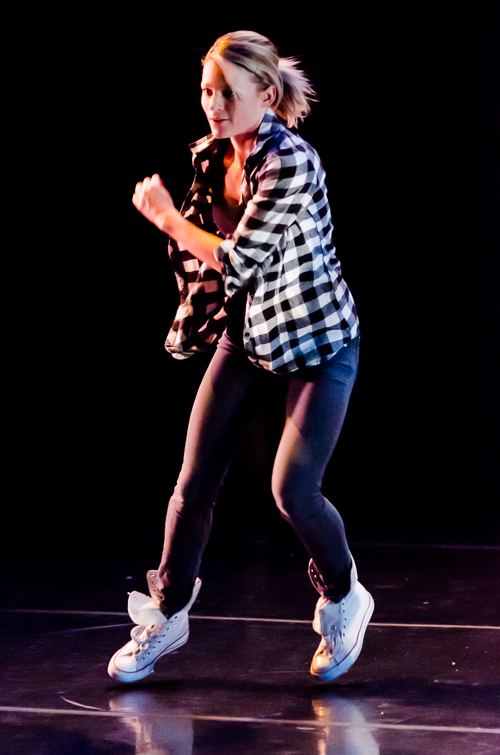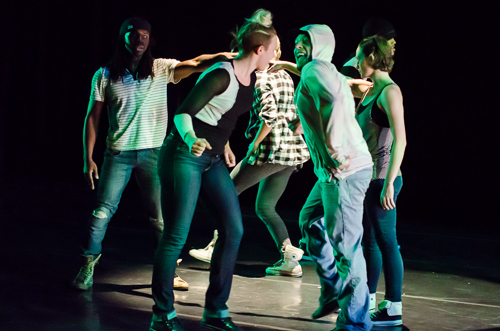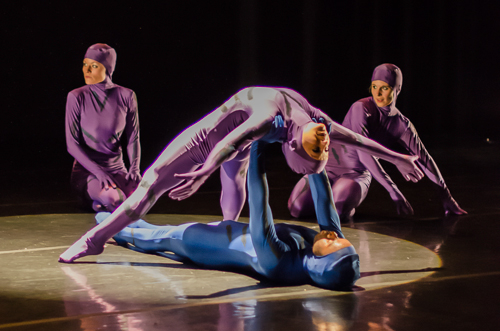Opposites attract, and not just in the ways that you've probably heard about. Beyond the stereotypes of romance and the science of electromagnetism, there's a thread that runs through some of the most innovative kinds of creativity and reflects much the same idea.
One of the things that often characterizes creative minds is the ability to see, and weave together, ideas that everybody else would see as unconnected, incompatible, or even contradictory. Sometimes this is deliberate, like the way that a master chef may combine unexpected ingredients in some new way, but more often it's the result of an artist's inability to see things divided into categories the way others do, because the way they see is so much more inclusive. That's the way that Jessica Deahr sees the art of concert dance, and because she's just been named the new artistic director of Chicago Dance Crash, there are likely to be even more imaginative things coming out of that very creative Dance Company.

Jessica Deahr (Photo by Johnny Nevin)
Deahr has been with Dance Crash since 2007, first as a guest artist, and since 2009 as a Company member. As a dancer, her range of interest, experience and expertise is itself a defiance of boundaries; her biography lists "contemporary, ballet, jazz, modern, hip hop, breakdance, ballroom, tap, and fusions of various styles," somehow leaving out her performances as an aerial artist. She's performed with artistically committed concert dance companies, and she's toured the world as a performer in events as different as USO shows and cruise liner entertainment (including being lowered on a silk rope, spinning, fifty or sixty feet above a swaying ship into an opening in the deck the size of a manhole cover).
"I'm not the 'best' dancer of any of the styles I'm trained in," she says, although a lot of people who've seen her perform might argue with the accuracy of that statement. "My childhood training, and the training I've done as a working dancer is so varied and all over the place, and yet I've been able to make a living out of what I love to do because I'm a 'mover.' I can come off as a freestyle hip hop girl one night, record motion capture acrobatics the next day, teach pro jazz the day after that and close it out with some choreo that blends swing, hip hop, and lifts. That's what dance is all about these days."
Her work as a choreographer is even more broad-based, if that's possible. When choreographing, Deahr can draw from all of her varied experience, but only as much as the work really needs. "When left to my own devices, I'm more likely to just let choreography flow, and not constantly analyze what styles are coming out," she says. "If a choreographer is comfortable enough in a range of styles to just let it flow, it normally makes for the best fusion." Deahr has done this in original choreography that covers the same broad landscape she's explored as a dancer, and to real acclaim. In reviews of her evening length work Gotham City, critics, like the rest of the audience, were as positive as they have been for other Deahr choreography, scattering terms like "jaw-dropping", "virtuosic", "dynamic", and "terrific" through their descriptions of her work.
Deahr's versatility isn't at all an end in itself; it seems more to be her way of discovering an artistic expression that can go more places, because it's been more places. It's also not the full story of how differently Jessica Deahr sees dance. Her ability to evade stylistic boundaries is certainly a case of finding coherence where others would expect disconnection, but her vision for Chicago Dance Crash goes beyond just that. While many artists see an uncomfortable contradiction between artistic expression and audience approval, Deahr sees both parts of that apparent conflict with more clarity and in a more complete context. One of the secrets of Deahr's vision is that because she can see more of it, she can see right through it.

Kaitlin Webster, Brian Humpherys, Daniel Gibson, Mary Tarpley, Jessica Deahr, and David Ingram of Chicago Dance Crash in Rich Ashworth's The Social Element(Photo by Johnny Nevin)
"We got a compliment the other day in Chicago magazine when they promoted one of our shows by describing it as the show dancers will go see," she observes. "I thought that simple statement somehow spoke volumes about how hard we strive to keep things fresh and valid." It's quite a process, to start with an artistic vision and keep re-imagining it until experienced insiders and complete newcomers can both enjoy, and admire, the same art. "We're constantly striving for that perfect mesh of accessibility and art. We are not afraid to create a beautiful, intricate piece with layers of meaning, and we are not afraid to keep the audience in mind when creating it." For Jessica Deahr, those aren't even opposites, but there's still no telling what an audience they'll attract, now that more people are finding out.
This story originally appeared at aotpr.com

Daniel Gibson, Chantelle Mrowka, Jessica Deahr and Taylor Stewart of Chicago Dance Crash in Jon Lehrer's "Morphic Slip" (Photo by Johnny Nevin)
